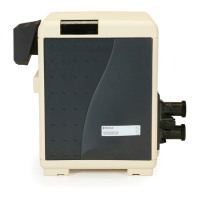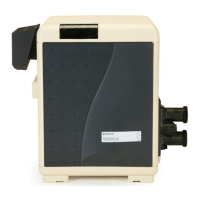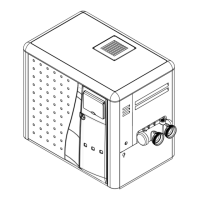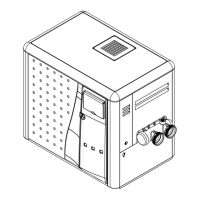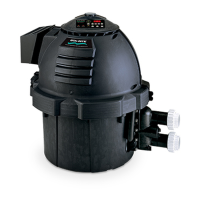P/N 475106 Rev. A 2/2014 MASTERTEMP
™
Pool and Spa Heater Installation and User’s Guide
| 19
5. Use approved fire stop for floor and ceiling penetrations. Use approved thimble for wall penetrations. Use a approved
roof flashing, roof jack, or roof thimble for all roof penetrations. Do not fill the space around the vent (that is, the clear
air space in the thimble or fire stop) with insulation. The roof opening must be located so that the vent is vertical.
6. Do not run the heater vent into a common vent with any other appliance.
WARNING
Fire Hazard. Do not vent the heater directly into a masonry chimney. Installation into a masonry chimney must use a
chimney liner which must meet local code standards and all local code requirements.
WARNING
Risk of fire, carbon monoxide poisoning, or asphyxiation. It is recommended to use a CO Monitor and Fire Alarm in rooms
that contain gas fired appliances.
HORIZONTAL OR VERTICAL VENTING - USING SINGLE-WALL STAINLESS
GAS VENT
(See Figures 23, 24 & 25)
Vent the heater either horizontally or vertically using an optional vent adapter of the 150 mm (6 in) or 102 mm (4 in) special
gas approved stainless steel vent pipes. Installation must be in accordance with all local codes and ordinances/or the
latest edition of the local code standards and/or local codes. The heater, when installed, must be electrically grounded and
bonded in accordance with local codes. Do not use a draft hood with this heater. Install the vent according to the vent
manufacturer’s detailed instructions. Note: Keep a 150 cm (6 in) minimum clearance between the vent pipe and combustible
surfaces. Follow the vent manufacturer’s instructions and code
requirements. Do not place any insulating materials around the vent or
inside the required clear air space surrounding the vent. See Table 7 for
maximum permissible vent lengths.
NOTE
The allowable vent runs for each vent pipe diameter are
different and can not be exceeded.
Each 90-degree elbow reduces the maximum horizontal vent
run by 3.6 m (12 feet) and each 45-degree elbow in the vent run
reduces the maximum vent run by 1.8 m (6 feet). See the
Table 7 for the maximum vent lengths using 90° elbows.
)ni4(mm201ro).ni6(mm051
tneVsaGlaicepS
)latnoziroHrolacitreV(
*
swoblE°09fo.oN
nihtgneLmumixaM
)M(teeF
0).tf83(m6.11
1).tf62(m8
*
niro).tf1(M43.0sihtgneltnevmuminiM
,noitcurtsnis’rerutcafunamtnevhtiwecnadrocca
stnevlatnoziroH.sedoclanoitandnalacoldna
aeriuqertonodhtgnelnisselro)ni3(m1
ehtdrawotnwodepolstsumtub,eetetasnednoc
wollaot).tf/ni4/1(retemehtotmc2tateltuo
.niardotetasnednoc
Table 7.
NOTE
It is recommended that vent runs over 5.4 m (18 feet) may need to be insulated to reduce condensation related
problems and/or the use of a condensate trap in the vent run close to the heater may be necessary in certain
installations such as cold climates. Horizontal vents 1 m (3 feet) or less in length do not require a condensate tee.
The MasterTemp heater is suitable for through-the-wall venting.
NOTE
After installation, installer must check for correct and safe operation of the heater.
Section 2. Installation

